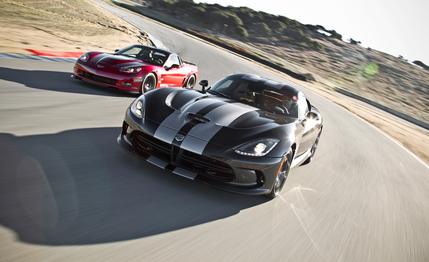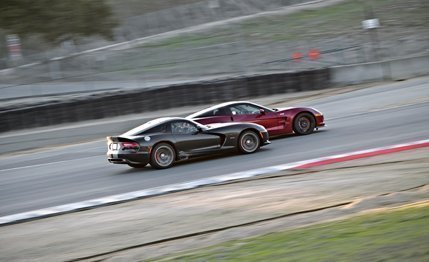
 Comparison Tests
Comparison Tests


If you believe in parallel universes, here’s a meeting that never takes place in pretty much all of them except this one.
Back in 2008, Chrysler was a financial boat anchor bumping along the bottom and looking to spin off the Viper’s nuts, bolts, and name for quick cash. Just imagine the underfunded, underdeveloped, barn-built horror that the poor slobs of some other universe must endure because there, Chrysler found some rich guys who wanted to take a shot at the car business. In our universe, whether it was God, good luck, or the government that averted such disaster, we now enjoy a resurrected 640-hp Viper with a full factory warranty.
The Corvette also faced its own mortality during GM’s recent existential crisis. But in this universe, it lives on in a seventh generation starting later this year. While we await the many permutations of the C7, including (we hope) another ZR1, we wanted to see how the new Viper rates against its arch nemesis and direct competitor for the title of America’s foremost supercar, the one that best brings big-bore raucousness into modernity.


Why, you ask? Because these cars have almost identical power and nearly identical gearing, and a mere three pounds separate their curb weights. Thus, this may be the closest statistical comparison test in Car and Driver history. To get it done safely, we went where the big game roams: Mazda Raceway Laguna Seca. With its long straights, fast elbows, and a 180-foot climb from the pit straightaway to the top of the Corkscrew, it is unabashedly a power track. For such a scene, our two protagonists come from central casting.
If you’ve been following breathlessly our recent Viper coverage, you know that Chrysler has built an all-new car that is strikingly familiar. Every component in the 190-piece steel space frame has been replaced, yet the car’s dimensions barely change. Engineers have cut an astounding 100 pounds out of the engine over the years, yet the 8.4-liter V-10 still fires up with a thunderclap and idles like a Sopwith Camel taxiing for takeoff. Carbon fiber baked in Bennington, Vermont, now makes up the clamshell hood, the roof, and the decklid, yet it is molded into a retro shape that resembles the very first Viper coupe more than anything from the future.


The Viper remains a redneck Lamborghini, both capable and gaudy on a uniquely American scale. But it also is hugely improved, from its more-closely spaced gear ratios to a suspension that has been reorganized to be more neutral and willing to change direction. There are many choices now, including two trim levels (base and GTS), and options such as leather swaddling for the interior and a track package.
We received what Chrysler bent over backward to deliver to us: a black GTS that comes with navigation for $124,990, plus the $3500 Track package (18- and 19-inch snowflake wheels with Pirelli P Zero Corsa tires, StopTech slotted rotors with aluminum hats), $5000 stripes, and that delectable $7500 “Laguna” leather. Basically, it’s the works, plus a gas-guzzler tax and delivery, for $140,990.


What is there to say about the ZR1 that hasn’t been said? Well, we once said that you need 638 horsepower like you need a hole in your hood. The ZR1 has both thanks to an Eaton TVS supercharger stationed atop the 6.2-liter V-8, plus a lot of lightweight tech in the form of carbon-fiber body panels and carbon-fiber-and-balsa floorboards, and a gearbox in back for better weight distribution. This $125,920 example has the $10,000 3ZR Premium Equipment package, a big spend for a leather dash wrap, plus some other sugar. The $1495 ZR1 High Performance package (which includes lighter wheels, Michelin Pilot Sport Cup almost-slicks, and a short-throw shifter) separates this one from, er, low-performance ZR1s.
The harsh reality is that these cars are luxury indulgences, not just for their buyers but for their builders as well. They consume time and resources and tend to return little to the corporate treasury despite their big price tags. In the parallel universe where car companies are run by people entirely dispassionate about cars, the ZR1 and Viper don’t exist. And we were never here.